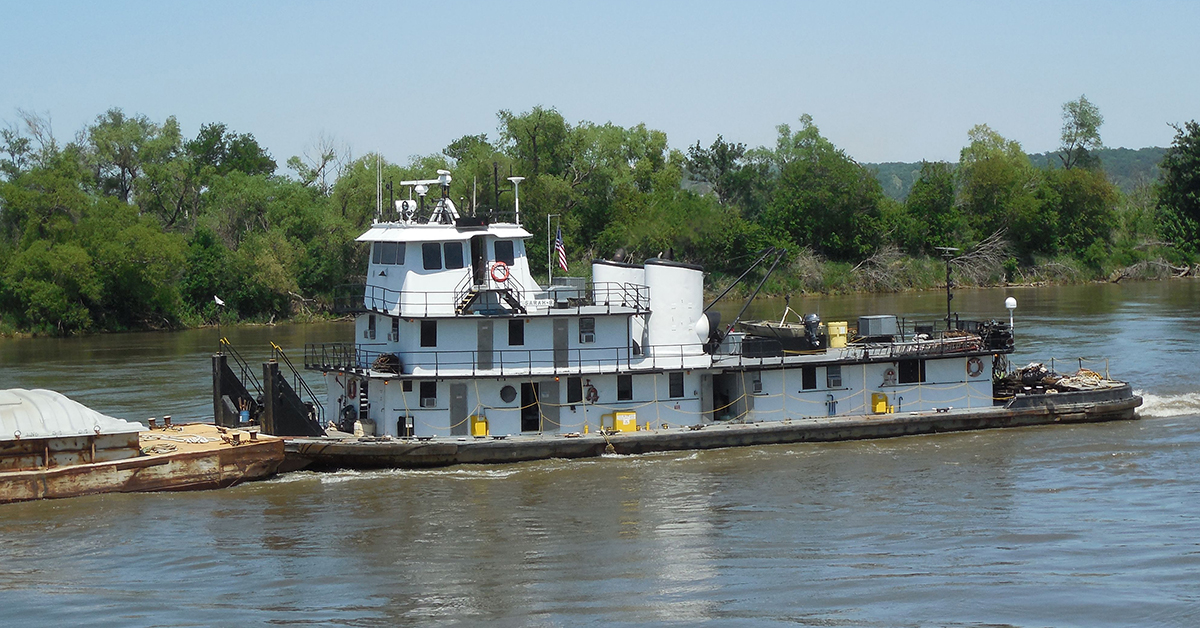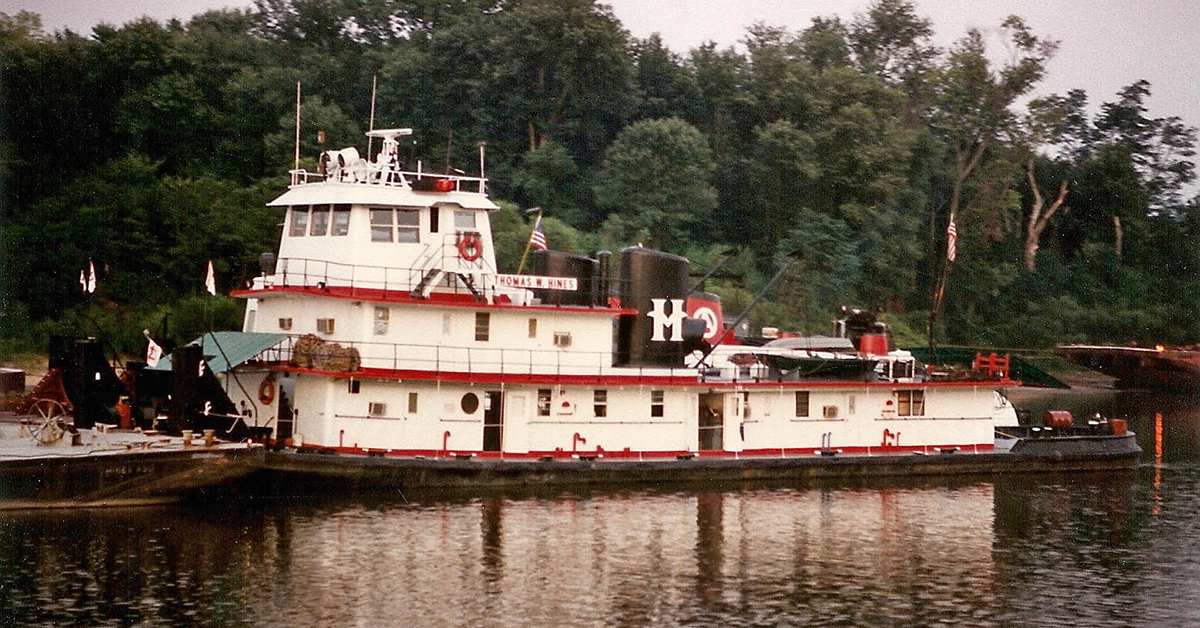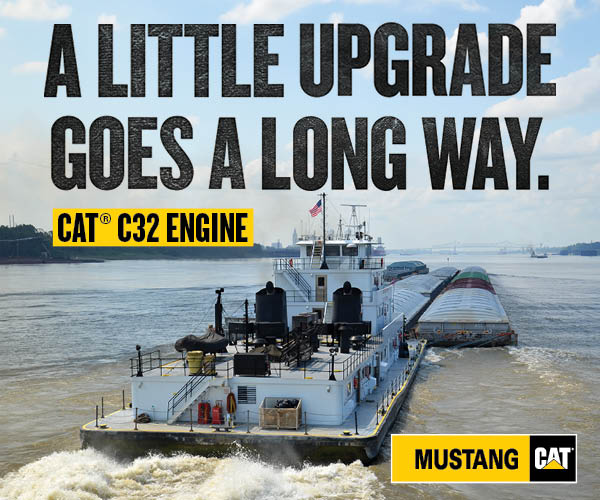In 1952, there were still many steam towboats roaming the Western Rivers of the United States. American Barge Line had seven in its fleet, all DPC prop steamers built during World War II. Amherst and Armco each had three. Federal Barge Line had 13, but an ad in The Waterways Journal said the company was taking bids on the steamer Cairo. Ohio Barge Line had three steam towboats, while the Ohio River Company had five. The giant steel and coal companies in the Pittsburgh pools had 11 steamers in active operation at that time, and there were yet many tugs, ferries and passenger and excursion steamers still in operation.
However, no steam towboat had been built since World War II, and diesel power was king in new construction.
Nashville Bridge Company of Nashville, Tenn. (Nabrico) was an early builder of diesel vessels. In fact, Nashville Bridge turned out the very first fully diesel towboat in 1923, the sternwheel Harvey. One of the first towboats built by Nabrico in 1952 was the 1,800 hp. Chippewa, built for Genessee Transportation Company, Waukesha, Wis. The Chippewa had the classic Nabrico styling, with pleasing sheer and camber to the hull and cabins, as well as a distinctive visor around the top of the pilothouse. The twin stacks carried a profile of an American Indian on each outboard side.
The Chippewa was powered by a pair of GM 12-567 diesel engines coupled to Falk 2.5:1 gears. The hull measured 124 feet by 27.5 feet, and under the stern were two steering and two flanking rudders. It had a dedicated tow of tank barges that it moved to various destinations on the Mississippi River system. The Chippewa continued in this trade for the next 19 years until May 1971, when it was sold to Hines Inc. of Bowling Green, Ky. Hines then renamed it the mv. Thomas W. Hines. This was the second boat of that name for the firm, with the first sold and renamed in 1970 (see WJ, February 5, 2024). As the Thomas W. Hines, the boat served in much the same way as when it was the Chippewa, towing a tank barge unit throughout the river system. The radio call sign was WE 2160.

In the pre-dawn hours of April 20, 1972, the Thomas W. Hines was making a downbound approach to the Cannelton Locks, Mile 720.7 on the Ohio River. Part of the dam was still under construction, but the sections already completed had the gates open in the “all out” position. The river was still on the rise. The tow consisted of two loads of gasoline and one empty barge.
Something went awry with the approach, and the boat and tow topped around. The boat went through the dam stern first, and crew members later stated that it rolled almost on its side. Lock employees said they were able to see the propellers as it passed through the dam.
One of the loaded barges partially sank on its side on the dam while the other partially sank a short distance below, and both were on fire. The empty barge was caught in the vicinity of Tell City, Ind. The master of the Hines had been off watch and made it to the pilothouse to find that the pilot was missing. The engines were still running, and he was able to nose the boat into the Indiana shore. The body of the pilot was found later about a hundred miles downstream. Thankfully, the rest of the crew survived the incident, and the boat only suffered minor damage. A photo taken of the Thomas W. Hines shoved in at the bank later that morning shows a tattered front awning, the starboard stack canted inboard, and the port searchlight aimed at the stern.
Following this incident, the Thomas W. Hines was a faithful workhorse in the Hines fleet for another 17 years. In 1985, it was repowered to 2,800 hp. with GM 12-645 E2 engines. In 1989, it was sold to Madison Coal & Supply of Charleston, W.Va., and renamed Dan’l Boone. It was then in a barge line trade on the Kanawha and Upper Ohio rivers until it was sold in 1994 to McKinney Marine Inc. of Baton Rouge, La., and renamed Glenn W. McKinney. In March 1996, JAR Assets Inc. purchased the boat, which was then operated by Mandeville, La.-based Florida Marine Transporters. It was renamed Sarah B and was once again in the tank barge trade. The boat received many upgrades at this time, including replacement of the original Nabrico air steering system.
In 2010, the Sarah B was sold to Knight Manufacturing Company of Rosiclare, Ill. Under this ownership, the vessel was often towing rock from a quarry at Cave-In-Rock, Ill., to a cement plant at Joppa, Ill. In June 2017, it was sold to Three Rivers Boat & Barge, Ledbetter, Ky., and operated under bare boat charter by other companies. In 2020, it was renamed Chelsey Alexis.
After a lengthy lay-up period, it was recently spotted beached out at Ledbetter, apparently for dismantling and scrapping. Throughout the 73 years since it left Nashville as a new boat, the outward appearance hardly changed.
Featured image caption: The Thomas W. Hines in the mid 1980s. (Photo by Barry Griffith)




